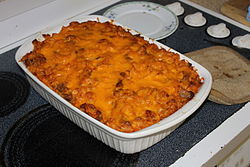 Johnny Marzetti is a pasta casserole popular in the American Midwest and the former Panama Canal Zone. | |
| Alternative names | Johnny Mazetti |
|---|---|
| Course | Main dish |
| Place of origin | United States |
| Region or state | Columbus, Ohio, Midwestern United States |
| Serving temperature | Hot |
| Main ingredients | Pasta, ground beef, tomatoes, cheese |
| Variations | mushrooms, vegetables, olives |
| Similar dishes | Chili mac, [1] American goulash [2] |
Johnny Marzetti, sometimes called Johnny Mazetti, John Mazzeti, or Joe Mazetti, [3] is an American casserole dish in the cuisine of the Midwestern United States prepared with pasta, ground beef and vegetables, typically in a tomato sauce, and topped with cheese before baking. [4]
Contents
It has been described as a signature dish of Columbus, Ohio. [5] [6] It is similar to American goulash and Chili mac. [1] [2]